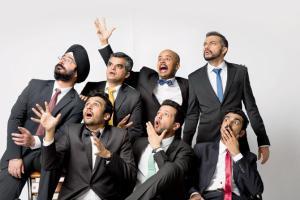Once upon a time, collectives fuelled the rise of stand-up comedy in the country. Now, comics rule the roost independently. How did this happen?

(Standing, from left) Angad Singh Ranyal, Atul Khatri, Sorabh Pant and Kunal Rao,with (seated, from left) Sahil Shah, Sapan Verma and Azeem Banatwalla, the original members of East India Comedy
Log on to an online ticketing platform. Click on the section with comedy shows. Take a look at the artistes on offer. And you'll find that most of them are individuals performing roughly one-hour shows. Or, the event is an open-mic one where established comedians test the waters with new material one by one, and recent entrants try and make their presence felt. That's just how the industry — and stand-up comedy in India is now a bona fide one for sure — works these days. But, that wasn't the case when the movement was still in its nascent phase.
Sure, the whole ecosystem was created at the turn of this decade when people like Papa CJ and Vir Das packed their international stand-up experience in a bag and took a flight back home. But it wasn't until roughly 2014 that the winds of change truly started blowing. And the ones who were fanning it were collectives like All India Bakchod (AIB), East India Comedy (EIC) and Schitzengiggles (SnG). These groups were started by some of the earliest movers in the scene, such as Karan Talwar, Sorabh Pant and Rohan Joshi. They whiffed an opportunity in the air and got a bunch of like-minded people to work as a group, giving stand-up comedy in the country wind in its sails.
ADVERTISEMENT
United they stand
The reason these collectives worked is that back then, the idea of this genre of entertainment was almost as alien to Indians as a Bollywood movie would be to people living in Greenland. "They (the collectives) were like really small start-ups, you could say, where multiple people were trying to get together and start a scene," Ankur Kaushik, artiste manager with Only Much Louder, a firm that handles most of the country's top comedians, explains. "And the reason they clicked is that no single individual could have put an event in place in those days. But together, they could pull in 50 to 100 people," he says.
This strength in numbers had an added advantage. Live comedy shows weren't as much in vogue as they are today. Atul Khatri, one of EIC's earliest members, remembers looking at people chance upon The Comedy Store in a Lower Parel mall and confusing the venue to be a shop that sells clown costumes, party poppers and things like that. So, the bread and butter for the first wave of performers came from alternative avenues, such as writing sketches and scripts for Bollywood awards shows, apart from brand content. "That's why we thought that collectives made sense because if you have to write for something like the [two-hour long] IIFA awards or one of our own video sketches, you need about four people to chip in," Khatri says.
Divided they fall
So that's how the Indian comedy circuit started gaining legitimacy until it became the entertainment behemoth it is at present. Audiences started understating the difference between a Kapil Sharma show and a Kunal Kamra set. Brands lined up for a slice of the pie. And most importantly, youngsters felt encouraged enough to take a leap of faith and start a career as a stand-up comedian.
But then something happened a little less than a year ago that disrupted the old order. The tidal wave of the #MeToo movement drowned AIB. The members of SnG parted ways over "creative differences" (read: legal disputes). And though EIC haven't put the lid on operations altogether, they did shutter their office space in 2019 to concentrate on their individual stand-up careers, which is where their passion lies. Does this thus signal a death knell for the collective comedy space in the country? EIC's Sapan Verma doesn't think so. "In fact, I think that because AIB and SnG have kind of vanished, and we have also reduced our volume of work, if some people come up as a collective right now, they will be in high demand. I'm saying that because I know that the amount of enquiries that our group still gets from brands is quite surprising," Verma says.
Time for togetherness?
He also says that something like an all-female collective might create a major ripple in the market. We put that same suggestion to Urooj Ashfaque, a bright young star in the scene. "I think that at some point we [young comedians] have all given the idea of starting collectives a thought. I personally don't have the drive to start one. But if someone else does it, I would totally join in. That's the honest answer," she says, meaning that, yes, there is a definite lull when it comes to forming comedy groups in India. And individuals are making hay while the sun shines. But is there a storm brewing in the horizon? Well, the forecast does point in that direction.
Catch up on all the latest Crime, National, International and Hatke news here. Also download the new mid-day Android and iOS apps to get latest updates
 Subscribe today by clicking the link and stay updated with the latest news!" Click here!
Subscribe today by clicking the link and stay updated with the latest news!" Click here!







